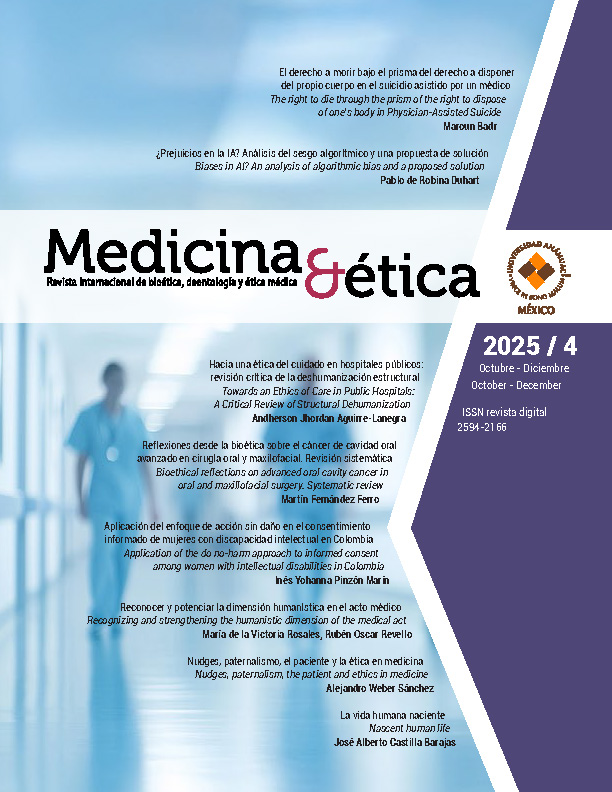Application of the do no-harm approach to informed consent among women with intellectual disabilities in Colombia
Main Article Content
Abstract
This article analyzes the relevance of the “Action No Harm Approach” (ANHA; in Spanish, Enfoque de Acción sin Daño, EASD) in obtaining informed consent in reproductive decisions of women with intellectual disabilities, who also face multiple forms of vulnerability. From a bioethical perspective, it raises the need to guarantee respect for the autonomy and dignity of these women, avoiding paternalistic practices or interventions that, although well-intentioned, may have adverse effects. The methodological proposal is qualitative and structured around the categories of ANHA, informed consent, reproductive decisions, intellectual disability, and vulnerability. Through a review of literature and case law, the study seeks to identify the models used in practice to obtain consent, noting the need for reasonable adjustments. The ANHA allows for a rethinking of interventions so that they are context-sensitive and promote truly informed decisions, without imposing undue burdens or substituting the will of the women involved.
Downloads
Article Details
Section

This work is licensed under a Creative Commons Attribution-NonCommercial-ShareAlike 4.0 International License.
Medicina y Ética is distributed under a Creative Commons License Atribución-NoComercial-CompartirIgual 4.0 Internacional.
The author keeps the property rights with no restriction whatsoever and guarantees the magazine the right to be the first publication of the work. The author is free to deposit the published version in any other medium, such as an institutional archive or on his own website.
How to Cite
References
1. Beauchamp T, Childress J. Principles of Biomedical Ethics. 7th ed. New York: Oxford University Press; 2012.
2. Gracia D. Procedimientos de decisión en ética clínica. 3a ed. Madrid: Editorial Triacastela; 2008.
3. Gadamer H. Verdad y método. Salamanca: Editorial Sígueme; 1984.
4. Charon R. Narrative Medicine: A Model for Empathy, Reflection, Profession, and Trust. JAMA. 2001; 286(15):1897–902. https://doi.org/10.1001/jama.286.15.1897.
5. Martha M. Narrative ethics. In: Narrative Ethics: The Role of Stories in Bioethics; 2014
6. Jonsen A, Toulmin S. The Abuse of Casuistry. Berkeley: University of California Press; 1988.
7. Jonas H. El principio de responsabilidad. Ensayo de una ética para la civilización tecnológica. Barcelona: Herder Editorial; 2004.
8. Pellegrino E, Thomasma D. For the patient’s good: the restoration of beneficence of the healing professions. New York: Oxford University Press; 1988.
9. Wallace M. From Principle to Practice. A User’s Guide to Do No Harm. Cambridge: Collaborative Learning Projects (CDA). Disponible en: https://www.cdacollaborative.org/?smd_process_download=1&download_id=3948
10. Anderson M. Acción sin daño: cómo la ayuda humanitaria puede apoyar la paz o la guerra. Londres: Lynne Reinner Publishers; 1999.
11. Abellán J. Bioética, autonomía y libertad. España: Fundación Universitaria Española; 2006.
12. Wallace M, Ziai A. From Principle to Practice. A User’s Guide to Do No Harm / Development Discourse and Global History: From Colonialism to the Sustainable Development Goals. Cambridge/Londres: CDA Collaborative Learning Projects / Routledge; 2016.
13. Sgreccia E. Manuale di Bioética. Milano: Vita e Pensiero; 1994.
14. Langa Herrero A, Rey Marcos F. La acción sin daño y los proyectos de desarrollo: una alternativa práctica de triple nexo. Rev Esp Des Coop. 2023; 50(2):199–212.
15. Rabadán AT, Tripodoro VA. ¿Cuándo acudir al comité de bioética institucional?: El método deliberativo para resolver posibles dilemas. Medicina (B Aires). 2017;77(6):486–90. Disponible en: https://www.scielo.org.ar/scielo.php?script=sci_art-text&pid=S0025-76802017000600007
16. Beauchamp T, Childress J. Principles of Biomedical Ethics. 7th ed. New York: Oxford University Press; 2012
17. Mackenzie C. Autonomía relacional, autonomía normativa y perfeccionismo. Humanitas Hodie; 2020
18. Asociación Americana de Discapacidades Intelectuales y del Desarrollo (AAIDD). Definición de la discapacidad intelectual; 2022.
19. Morrison J. DSM-5® Guía para el diagnóstico clínico. Ciudad de México: Editorial El Manual Moderno; 2015.
20. Lezak MD, Howieson DB, Bigler ED, Tranel D. Neuropsychological Assessment. 5th ed. Oxford: Oxford University Press; 2012.
21. Ministerio de Salud y Protección Social. Orientaciones técnicas para la implementación del consentimiento informado para personas con discapacidad, en el marco de los derechos sexuales y derechos reproductivos. Bogotá: MinSalud; 2018.
22. Consejo Nacional para Prevenir la Discriminación. Nada sobre nosotros sin nosotros: La convención de Naciones Unidas sobre discapacidad y la gestión civil de derechos. México: CONAPRED; 2016.
23. Oliver M. The Politics of Disablement. London: Macmillan Press; 1990.
24. Palacios A. El modelo social de discapacidad: orígenes, caracterización y plasmación en la Convención Internacional sobre los Derechos de las Personas con Discapacidad. Madrid: CERMI; 2008.
25. Ministerio de Salud y Protección Social. Orientaciones técnicas para la implementación del consentimiento informado para personas con discapacidad, en el marco de los derechos sexuales y derechos reproductivos. Bogotá: MinSalud; 2018.
26. Ministerio de Salud y Protección Social. Orientaciones técnicas para la implementación del consentimiento informado para personas con discapacidad, en el marco de los derechos sexuales y derechos reproductivos. Bogotá: MinSalud; 2018
27. Ten Have H. The Idea of Vulnerability. In: Vulnerability. 1st ed. United Kingdom: Routledge; 2016.
28. Fraser N. Escalas de justicia. Barcelona: Herder; 2008. Fraser N, Honneth A. ¿Redistribución o reconocimiento? Madrid: Morata; 2006. Luna F. Vulnerabilidad: la metáfora de las capas. Jurisprudencia Argentina. 2008; IV(1):60–7.
29. Luna F. Vulnerabilidad: la metáfora de las capas. Jurisprudencia Argentina. 2008; IV(1):60–7.
30. Garrafa V. Da bioética de princípios a uma bioética interventiva. Rev Bioét (Impr.). 2009; 13(1). Disponible en: https://revistabioetica.cfm.org.br/revista_bioetica/article/view/97
31. Briceño AM. El principio de precaución en una sociedad de riesgos ambientales. Bogotá: Universidad Externado de Colombia; 2017.
32. Kottow M. Acerca del ‘principio’ precautorio. Bioética y precaución. Nuevos Folios de Bioética. 2011; (5):7–26. Disponible en: https://www.revistas.uchile.cl/index.php/NFB/article/download/32902/34639
33. Beauchamp T, Childress J. Principles of Biomedical Ethics. 7th ed. New York: Oxford University Press; 2012.
34. Organización de las Naciones Unidas (ONU). Convención Internacional sobre los Derechos de las Personas con Discapacidad; 2006.
35. Martínez J. Los ajustes razonables como medida de integración laboral de las personas con discapacidad. Rev Derecho. 2022; 23(1):187-211.

